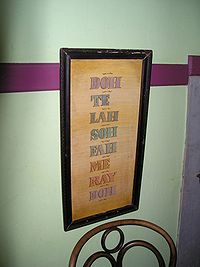
Back Tònic sol-fa Catalan Tonic sol-ffa Welsh Relativ solmisation Danish Tonic sol-fa German Tonic sol-fa Spanish Suhteline kõrgustähistus Estonian Sólfá tonach Irish Tonic sol-fa Italian 계이름 Korean Tonica sol-fa Portuguese
This article includes a list of references, related reading, or external links, but its sources remain unclear because it lacks inline citations. (April 2017) |

Tonic sol-fa (or tonic sol-fah) is a pedagogical technique for teaching sight-singing, invented by Sarah Ann Glover (1785–1867) of Norwich, England and popularised by John Curwen, who adapted it from a number of earlier musical systems. It uses a system of musical notation based on movable do solfège, whereby every note is given a name according to its relationship with other notes in the key: the usual staff notation is replaced with anglicized solfège syllables (e.g. do, re, mi, fa, sol, la, ti, do) or their abbreviations (d, r, m, f, s, l, t, d). "Do" is chosen to be the tonic of whatever key is being used (thus the terminology moveable Do in contrast to the fixed Do system used by John Pyke Hullah). The original solfège sequence started with "Ut", the first syllable of the hymn Ut queant laxis, which later became "Do".
© MMXXIII Rich X Search. We shall prevail. All rights reserved. Rich X Search